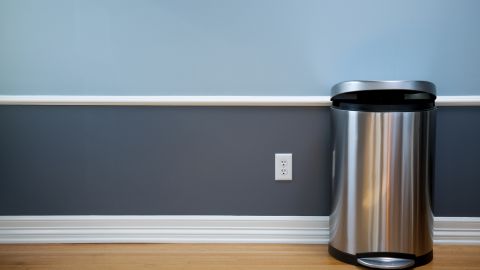Now you’ve swapped to environmentally friendly shopping bags, take the next step and look at your bin liners. The City of Sydney’s zero waste coordinator Matshepo Molala shares her tips for avoiding plastic liners.
First look at reducing the waste going in your red lid bin. You may be throwing away a bunch of household waste items you can recycle.
Hard plastics should go in the yellow lid bin, and you can recycle soft plastics with the REDcycle program at your local supermarket.
If you’re not ready or able to set up a compost bin or worm farm, there are other ways to compost at home, whether you live in a house or apartment.
Matshepo recommends separating your waste straight away in the kitchen.
Setting up specific, easy to access places to put each type of waste will greatly reduce the time needed to separate your waste and the amount of rubbish that ends up in the red lid bin.
With these simple systems in place, you may be surprised how little waste your household generates.
1. Reuse packaging you already have
With less waste now heading to your household rubbish bin, try reusing satchels from mail parcels or re-purposing small plastic bags. This turns single-use plastic into multi-use plastic. But it also sends recyclable packaging to landfill.
2. Use newspaper
If you’re a newspaper-reading household, try repurposing the paper to line your bin.
Check out a DIY paper bin liner tutorial or simply place the sheets along the base and sides of your bin. When the bin is almost full, fold the paper over the top to create a parcel and place in your red lid bin.
If you read the news online, this option may not suit you. So maybe you’re ready to go nude.
3. Go nude
You’ve done the hard work by separating compostable and recyclable materials, so you could skip having a bin liner at all. Gasp! Empty your remaining waste directly in the red lid bin. A regular bin wash is all that’s needed.
The nude option works well if you compost your food waste or wrap wet waste in newspaper or non-recyclable plastic wrapping. Your bin will be less icky and will require less cleaning.

4. The biodegradable or compostable bag
If none of these options suit your household, compostable bin liners are an enviro-friendly option.
“Compostable bags are designed to break down – but only in certain well-functioning composting conditions. Some types only degrade in commercial composting facilities, so make sure you check the label,” said Matshepo.
“The City’s red lid bin waste is transported to an alternative waste treatment facility in Kemps Creek. This industrial facility turns compostable material from domestic waste and street litter bins into a low-grade compost.”
The verdict
There’s no one-size-fits-all solution. Bin liners are not an easy plastic item to replace, so explore and test different options that work for you. Try each option for a week or 2 and see what works best in your home.
Published 5 November 2018, updated 17 November 2018



